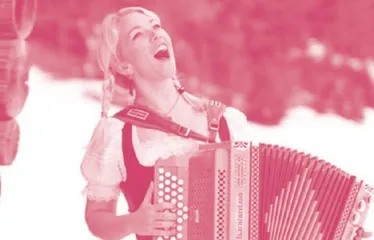Kulning: A Hypnotic Swedish Singing Tradition“库尔宁”:一种有魔力的瑞典歌唱传统
作者: 贾斯廷·考尔德伦 秦书未

Skallskog is a secluded farm without running water or electricity that most Swedes have never heard of. Hidden deep in the Nordic wilderness, this humble collection of cattle barns and russet-red farmhouses may seem like a place of little importance. But this is where you’ll find the disappearing roots of an ancient Swedish singing tradition so intimately connected to nature that it can only be described as magic.
Kulning is a vocalisation tradition that dates back to the Middle Ages, where singers corral1 farm animals with hypnotic melodies, luring cows, goats, sheep and ducks towards them as if each note was charged with its own gravity. This mystical ability originates from centuries-old fäbods2 (summer farms) like Skallskog, where farmwomen would traditionally call their meandering animals back home as they grazed freely during the few warm months in these frigid lands. In recent decades, as women’s place in society has shifted, these sounds have transformed from farmland pragmatism3 to operatic4 ele-gance.
A kind of Nordic yodelling5-meets-Dr Doolittle6 superpower, modern Kulning has a bewitching quality that inspired Disney to include its entrancing melodies in Frozen 2. In 2016, YouTuber Jonna Jinton posted a video of her Kulning to cows that racked up more than eight million views. And outdoor concerts and folk music festivals featuring trained Kulning singers are continuing to popularise this spellbinding art of communicating with nature.
This form of herd-calling connects hyper-digital Sweden to its pastoral past. Yet, just as Swedes have become increasingly detached from the farm, the origins of Kulning have come close to being forgotten.
I visited Skallskog in late September as part of my search for a summer farm where Kulning was once routinely practiced.
“Kulning is a vocal technique born out of function. It happens across several regions in the Nordic countries. Norway, of course, but also historically in eastern Finland,” Jennie Tiderman-Österberg, a trained opera singer and former punk rocker told me on the drive from the train station to the farm, explaining that the musical tradition started in the stubborn soil of Scandinavia’s frozen farmlands that made Kulning more necessity than art. Farmers here are migratory and herd their animals to fäbods during the summer months to graze on fresh grass. Unlike many herding cultures, Scandinavia’s shepherds were mostly women that employed high-pitched animal mimicry.
“The long, ornamented7 and melismatic8 calls are often directed towards cows. Goats and sheep have different sounds; often shorter, more rhythmical, and more guttural9,” she said, adding that the “magic” that makes Kulning work is a combination of controlling how one’s voice travels across natural landscapes and a knowledge of animal calls.
I’d arrived in Sweden just in time to attend one of Tiderman-Österberg’s last Kulning concerts of the season. The venue was a sunken silver mine in a hilly pine forest south of Borlänge that provided the necessary natural acoustics. An audience of about 20 people set up camping chairs around an impossibly brilliant turquoise pool formed by the sunken mine, while she and two other female Kulning singers and a man with a cow horn spread out around us, facing away so as not to project directly at anyone.
In this sense, the outdoor setting is practical: “There are such strong sounds in Kulning you could make someone deaf if you use it in a room or even in a concert hall,” said Tiderman-Österberg.
A piercing call suddenly burst through the majestic silence of the wilderness. Starting with an undulating melody from one of the singers hidden just beyond the tree line, the performers took turns calling their hypnotic chorus to invisible animals. The song’s primordial force seemed to awaken something unseen. Birds chirped in response, or perhaps as an accompaniment. A natural echo added to the music. Tree leaves shook; whether it was the wind or spirits, I could not tell.
When it was Tiderman-Österberg’s turn, she rang a cowbell to help visualise the animals she was calling upon. “I need to hear the sound of the cattle to call on them, even if they are imaginary in an open-air concert,” she later told me. “But I can almost sense the smell of them and hear their bellowing when I hear the cowbell. They become a part of the sense-scape that creates the right feeling for me. Then I get in contact with all the women who sang before me in these forests. It’s quite spiritual, real-ly.”
Alice Gustafsson, 81, is one of these women. She learned to walk at Skallskog many decades ago, and still marches her animals here every summer, a 20km walk from the farm in Dalarna that her family uses for the rest of the year.
Gustafsson’s relationship with her six cows—how she mimics their voices and cares for them—is a rare snapshot10 of what Kulning originally was. “I don’t practice Kulning the way that many of us talk about [it] today, but I do communicate with the animals. I call on them, talk with them and sing to them, just as a way to relate,” she said. “They are part of my family.”